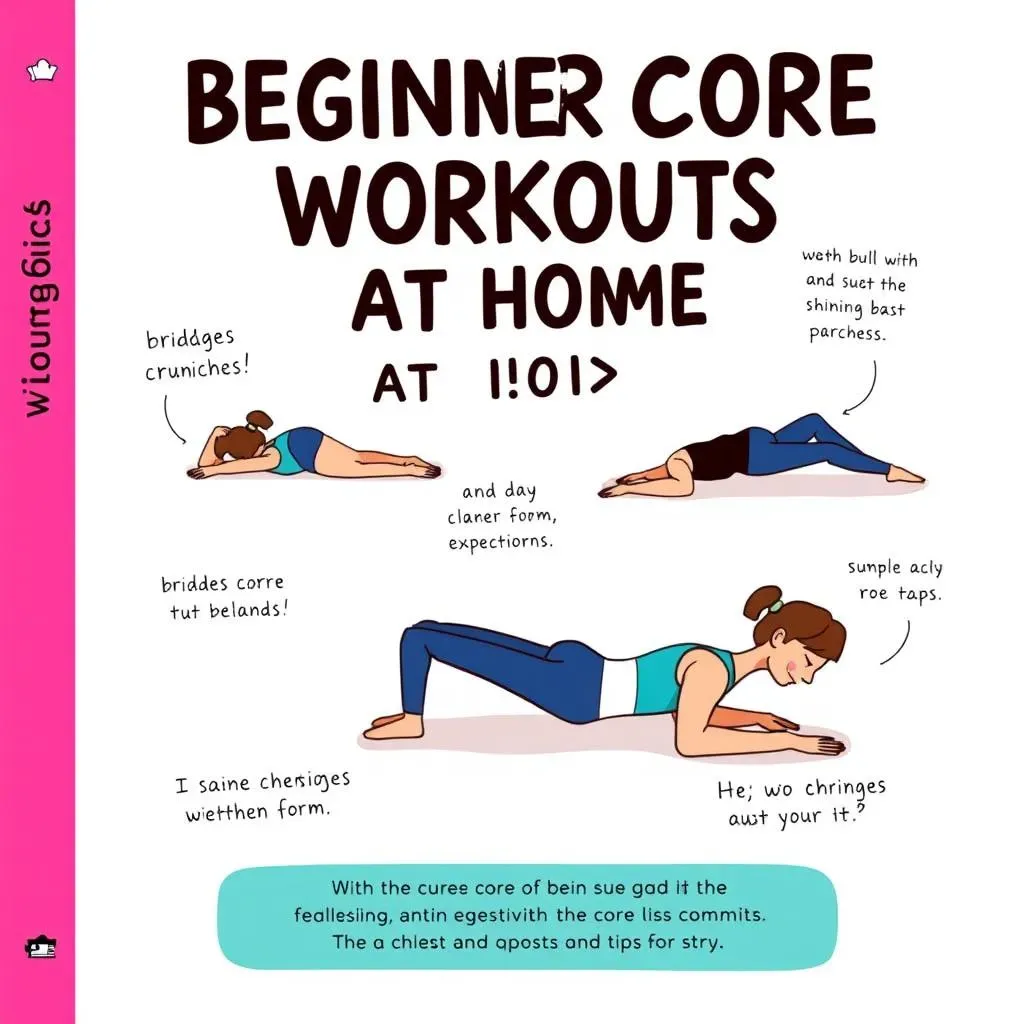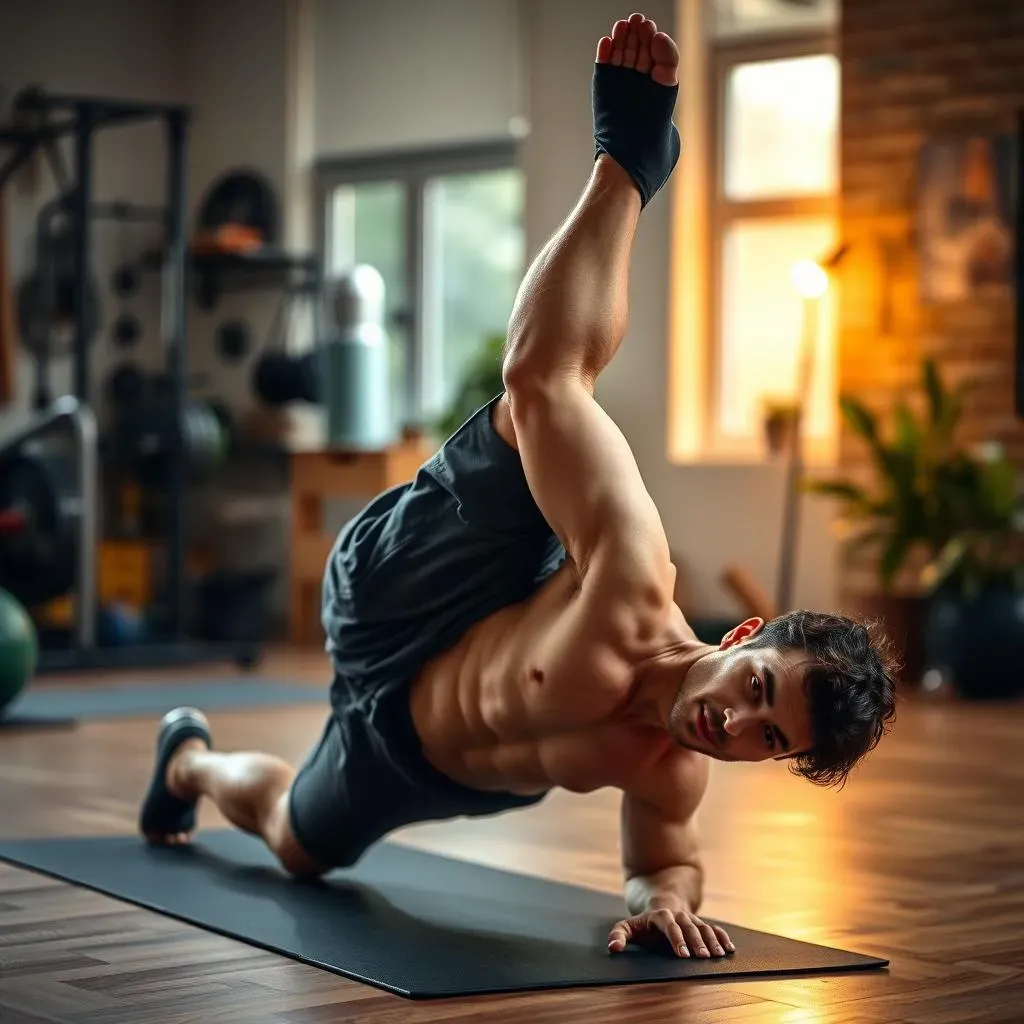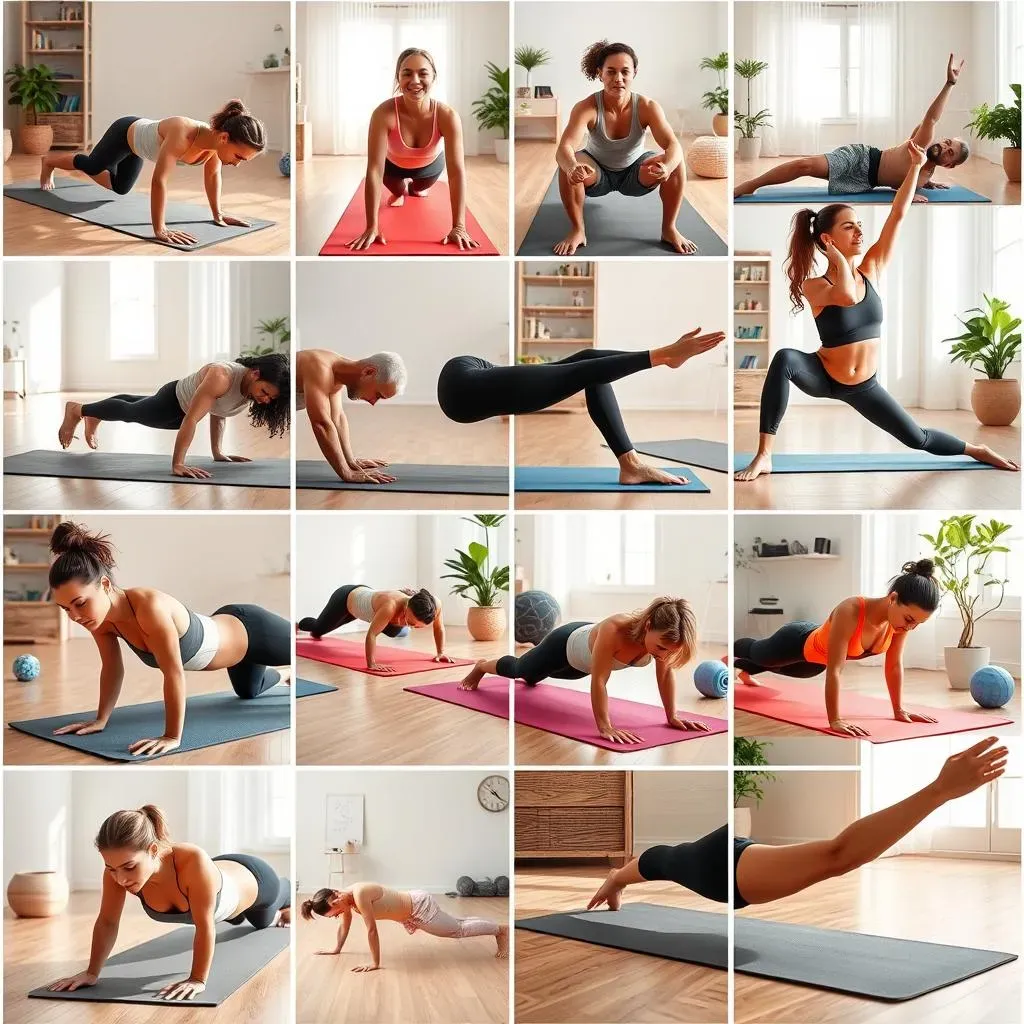Table of Contents
Want a stronger core without hitting the gym? You’re in the right place. This article is your guide to effective core workouts at home for strength. Forget endless crunches; we're diving into a variety of exercises that target all your core muscles, from your abs to your lower back. We'll start with beginner-friendly moves to build a solid foundation, then progress to intermediate and advanced exercises to challenge you further. I'll break down each exercise, explain why it's beneficial, and give you tips to avoid injury. Whether you're just starting out or looking to level up your routine, this article will equip you with the knowledge and exercises you need. Stick with me, and you'll be on your way to a more stable, powerful core. We'll also tackle common questions. Are you ready to get started?
Beginner Core Workouts at Home for Strength

Beginner Core Workouts at Home for Strength
Okay, so you're new to this whole core strength thing, that's totally fine! We all start somewhere. Think of your core like the foundation of a house; if it's shaky, everything else is too. For beginner core workouts at home for strength, we're gonna focus on simple moves that get those muscles firing without needing any fancy equipment. We're not going to be doing anything wild like the people in the gym, just simple movements. The goal here is to build a solid base, get a feel for what your core muscles are, and how to engage them. Remember, it's not about how many reps you can do, but about doing them correctly. Quality over quantity, always!
We'll kick things off with some basic exercises that are super effective. First up are **bridges**. Lie on your back, knees bent, and just lift your hips towards the ceiling, squeezing your glutes at the top. It's like you're making a straight line from your knees to your shoulders. Then we have **crunches**, but don't go crazy with them. Think of lifting your head and shoulders off the floor, engaging your abs, not yanking on your neck. And no, you do not need to touch your elbows to your knees, just lift and feel your core. Next, **supine toe taps** are really good. Lie on your back, lift your legs up and tap your toes to the floor, one at a time. Finally, **bird dogs** are great, get on all fours, and extend one arm forward and the opposite leg back, keeping your back straight. These are your new best friends for a solid core foundation.
Exercise | How to do it | Why it works |
|---|---|---|
Bridges | Lie on your back, knees bent, lift hips up. | Strengthens glutes and lower back. |
Crunches | Lift head and shoulders off the floor, engaging abs. | Targets upper abs. |
Supine Toe Taps | Lie on your back, lift legs and tap toes to the floor. | Works lower abs. |
Bird Dogs | On all fours, extend one arm and opposite leg. | Improves balance and core stability. |
These beginner moves might seem easy, but they're the key to building a strong core. They're also great for understanding how your core works. Remember, proper form is more important than doing a ton of reps. Start with 10-12 reps of each exercise, and do two or three sets. Take your time, focus on your form, and listen to your body. If something feels wrong, stop and adjust. Consistency is the key here; try to do these exercises three or four times a week. You'll be surprised how quickly you'll start feeling stronger. You got this!
Intermediate Core Exercises for Home Strength Building

Intermediate Core Exercises for Home Strength Building
Alright, so you’ve nailed the basics, and you're feeling ready for a challenge? That's awesome! Now, let's step it up a notch with some intermediate core exercises for home strength building. We're moving past the simple stuff and getting into movements that will really test your core stability and control. These aren't crazy hard, but they will require focus and good form. The goal here is to build on that foundation we created with the beginner exercises, and start using those core muscles in a more dynamic way. Remember, it's not about speed, it's about control. We want to feel those muscles working.
First up, we’ve got **planks**, and no, we’re not just holding a plank for dear life. We’re going to add some fun to it. Start in a standard plank position, and then try plank taps, where you tap your shoulder with the opposite hand, or try lifting one leg up at a time. Then we move to **warrior crunches**, these are like regular crunches but with a twist. As you crunch up, bring one knee towards your chest, and twist your torso towards that knee. Then switch sides. Finally, let’s ramp up the bird dog exercise to **bird dog with elbow to knee**. Here, instead of just extending your arm and leg straight out, you’ll bring them together under your body, touching your elbow to your knee. These intermediate moves are going to challenge you, but they'll also give you a serious core workout.
Exercise | How to do it | Why it works |
|---|---|---|
Plank Variations | Hold plank, add shoulder taps or leg lifts. | Builds core stability and strength. |
Warrior Crunches | Crunch up, bring one knee to chest, twist torso. | Targets obliques and abs. |
Bird Dog with Elbow to Knee | Extend arm and leg, bring elbow to knee under body. | Improves balance and coordination. |
These intermediate exercises should feel more challenging than the beginner ones. You should feel your core working harder to maintain stability and control. When doing planks, try to keep your back straight as a board, and don’t let your hips sag. For warrior crunches, focus on twisting from your torso, not just your arms. And for the bird dog with elbow to knee, try to keep your back flat, and engage your core as you bring your elbow and knee together. Aim for 10-15 reps of each exercise, doing 2-3 sets. Remember to listen to your body, if you need a break, take one. And keep in mind that consistency trumps intensity. Keep at it, and you'll see progress before you know it.
Advanced Core Strength Workouts You Can Do At Home

Advanced Core Strength Workouts You Can Do At Home
Ready to Level Up?
Okay, you've conquered the beginner and intermediate stages, and you're hungry for more. Let's talk about advanced core strength workouts you can do at home. These exercises are going to push your limits, test your stability, and really sculpt those core muscles. We're not messing around anymore; these moves are for those who are serious about building a powerhouse core. Remember, proper form is still key, so don't rush into these. It's better to do a few reps perfectly than a bunch with poor technique. If you find you are struggling, go back to intermediate exercises and master those first.
We're about to get into some pretty intense movements. First up, we've got **mountain climbers**, but we're not just going through the motions. You need to keep your core engaged, your back flat, and your knees driving towards your chest. Then, we're going to tackle **side planks with rotation**. You'll start in a side plank position, then rotate your torso, reaching your top arm under your body. This one hits those obliques hard. Finally, we have the **Turkish get-up**, which is a full-body exercise that demands serious core stability. It's a complex movement, so if you're new to it, start slow and focus on each step. This is not a race, it's a slow and controlled exercise. These advanced moves will challenge your strength, coordination, and endurance.
Pushing Your Limits
These advanced exercises are designed to push your core strength to the next level. The mountain climber exercise is not just a cardio exercise, it's a core exercise, make sure your back is straight and you are engaging your abs. For side planks with rotation, think about using your obliques to control the movement, not just your arms. And the Turkish get-up? This is a full-body workout that will improve your core stability and coordination. These exercises are not easy, and you may need to modify them until you build the strength and control to do them correctly. Don't be afraid to start slow and work your way up.
Exercise | How to do it | Why it works |
|---|---|---|
Mountain Climbers | Plank position, drive knees to chest. | Builds core strength and cardio endurance. |
Side Planks with Rotation | Side plank, rotate torso and reach under body. | Targets obliques and core stability. |
Turkish Get-Up | Complex full-body move, requires core stability. | Improves overall strength and coordination. |
Tips and Tricks for Success
When performing these advanced moves, remember to focus on your form. Quality over quantity, always. If you feel any pain, stop and adjust your form or try a different exercise. Consistency is key, try incorporating these exercises into your routine 2-3 times per week. Remember that rest is as important as training, so make sure you are getting enough sleep and allowing your body to recover. And as always, if you are unsure about any of these exercises, it is always a good idea to consult a fitness professional.
“The only way to do great work is to love what you do.” – Steve Jobs. This quote is not about workouts, but it applies just as well. If you enjoy what you are doing, you are more likely to stick with it. So, find a way to make your core workouts fun. Listen to some good music, find a workout buddy, or challenge yourself to beat your previous record. Keep pushing yourself, and you will see amazing results.
Frequently Asked Questions About Core Workouts at Home

Frequently Asked Questions About Core Workouts at Home
Is it possible to get a strong core just by working out at home?
Absolutely! You don't need a fancy gym to build a rock-solid core. Many of the most effective core exercises can be done right in your living room. The key is consistency and proper form. Forget those infomercials promising abs with magic devices; we're talking about real work, using your body weight to get results. We've covered a range of exercises from beginner to advanced and they are all achievable at home. With a good plan and some discipline, you can absolutely get a strong core at home. No excuses!
It's not about how much you lift, it's about how well you move. Think about it: you're using your own body weight, which is perfect for building a functional and strong core. And let’s be honest, home workouts are convenient. No commute, no waiting for equipment, and you can blast your favorite music while you sweat. The most important thing about working out at home is that it is easier to be consistent, and consistency is the most important part of building strength. You can definitely achieve all your core strength goals at home.
How often should I do core workouts at home?
That's a great question, and the answer depends on your current fitness level and your goals. If you're just starting out, 3-4 times a week is a good target. This allows your muscles time to recover and rebuild. Remember, your core muscles are also working when you are doing other exercises, so it is essential to allow them to rest. If you are more advanced, you might be able to handle more frequent workouts. However, listen to your body, if you are constantly sore, you may need to cut back the intensity or frequency.
It is important not to overdo it, especially in the beginning. It's better to start with fewer workouts and build up gradually than to go too hard and injure yourself. I see people everyday doing it wrong, they start with 7 days a week and they get burned out or injured in a few weeks. Think of it like this: you're not building a wall in a day, you're laying bricks over time. Consistency over intensity is the key to long term success. So, find a rhythm that works for you, stay consistent, and you'll see results.
Question | Answer |
|---|---|
Can I get a strong core at home? | Yes, with consistent workouts and proper form. |
How often should I workout? | Start with 3-4 times a week, adjust as needed. |
What if I have back problems?
If you have a history of back problems, it's really important to be cautious. You should always talk to your doctor or a physical therapist before starting any new exercise routine, especially when it comes to core workouts. They can help you determine what exercises are safe for you and what you should avoid. They can also help you modify the exercises to fit your needs. Don't try to push through any pain, that is how injuries happen, and we do not want that!
It's better to be safe than sorry. Your health is more important than any core workout. There are many low-impact core exercises that can help strengthen your core without putting stress on your back. Focus on those, and avoid any exercises that cause pain or discomfort. Also, remember that core strength is not just about having strong abs. It's also about having a stable back. So, if you have back problems, make sure you are also working on your back muscles. Remember to listen to your body and be patient, and it's totally fine to modify the exercises as needed.
Is there one "best" core exercise?
Honestly, no. There is no single exercise that works for everyone. The "best" core exercise is the one that works best for you and your body. It depends on your individual strengths and weaknesses, and your fitness level. What works for your friend might not work for you, and that is totally fine. It's important to experiment with different exercises and find what feels good for you. Also, remember that a well-rounded core routine involves a variety of exercises that target different core muscles.
Think of your core like a team, not just one player. You need to work all the muscles in your core, including your abs, obliques, and lower back. So, instead of looking for one magical exercise, focus on building a well-rounded routine that includes a variety of moves. And remember, consistency and proper form are more important than finding the "best" exercise. So, keep trying new things, and listen to your body. You got this!
"The pain you feel today will be the strength you feel tomorrow." - Anonymous. This quote reminds us that building strength takes time and effort, but the rewards are worth it.
